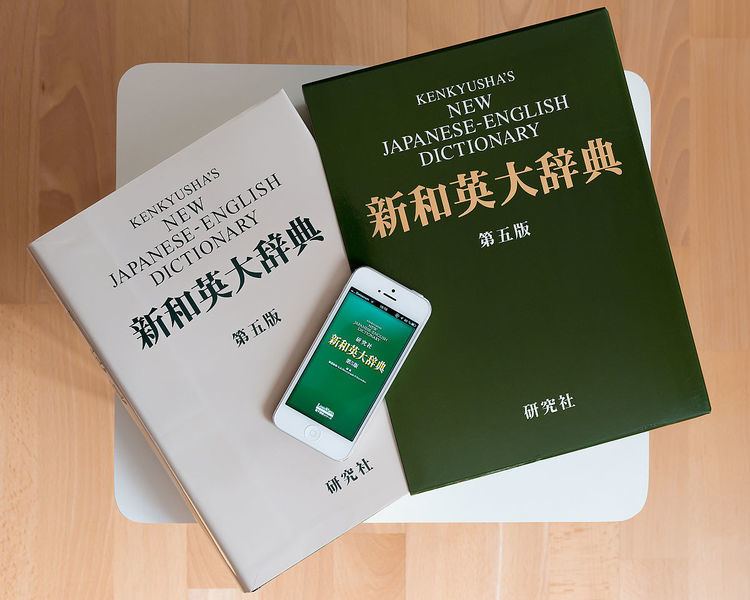 | ||
First published in 1918, Kenkyūsha's New Japanese-English Dictionary (新和英大辞典, Shin wa-ei daijiten) has long been the largest and most authoritative Japanese-English dictionary. Translators, scholars, and specialists who use the Japanese language affectionately refer to this dictionary as the Green Goddess or (GG) because of its distinctive dark-green cover.
Contents
The fifth edition of Kenkyūsha's New Japanese–English Dictionary, published in 2003 (colloquially "GG5"), is a volume with almost 3,000 pages; it contains about 480,000 entries (including 130,000 Japanese headwords, 100,000 compound words, and 250,000 example phrases and sentences), nearly all of which are accompanied by English translations. The editors in chief of the fifth edition are Watanabe Toshiro, Edmund R. Skrzypczak, and Paul Snowden.
Besides the print edition, the dictionary is also available on CD-ROM (EPWING format), online, and in electronic dictionary and iPhone versions. Electronic dictionaries that contain the fifth edition are generally flagship models. They include the Canon Wordtank G70, the Seiko SR-E10000 (the first electronic dictionary with GG) and SR-G10000, and the Casio "University Student" series (XD-D9800 in 2012) and "Professional" series (XD-D10000 in 2012).
There is also a companion English-Japanese dictionary, currently in its 6th edition, which contains 260,000 headwords.
History
In 1918, the publication of the first edition of Kenkyūsha's New Japanese–English Dictionary, Takenobu's Japanese–English Dictionary (武信和英大辞典, Takenobu wa-ei daijiten), named after the editor-in-chief, Takenobu Yoshitarō (武信 由太郎), was a landmark event in the field of lexicography in Japan. Completed in under five years with the assistance and support of leading scholars in the field, and published when Kenkyūsha (研究社) was still a minor academic publishing company, the Takenobu was the most authoritative Japanese–English dictionary of the time, and cemented Kenkyūsha's reputation in the field of academic publishing.
In 1931, Kenkyūsha undertook a major revision in the dictionary by expanding upon former entries and adding newer ones. The British diplomat George Sansom, who later became a renowned historian of Japan, was a major contributor and editor of this edition. Aside from the ever-evolving nature of the Japanese and English languages, competition from two other major dictionaries released in the 1920s – Takehara's Japanese–English Dictionary and Saitō's Japanese–English Dictionary, both of which were larger than the first edition of Kenkyūsha's – was probably a major driving force behind these revisions (although new editions of these dictionaries were never released, allowing Kenkyūsha's to assert and maintain its dominance among Japanese–English dictionaries). From this second edition onward, the dictionary became known as Kenkyūsha's New Japanese–English Dictionary. During World War II, reputable institutions in the United States and Great Britain, including Harvard University's Department of Far Eastern Languages, produced pirated versions of this dictionary for the war effort.
Because of the Pacific War, Kenkyūsha did not revise the dictionary for almost 20 years until 1949, when it decided to incorporate the many new borrowings from English that resulted from the American occupation of Japan. After five years of revision, Kenkyūsha published its third edition in 1954. Beginning with this edition and continuing through the 1974 fourth edition, the editors attempted to make the dictionary into a more scholarly work by citing English language expressions from English texts, particularly from literature; this, however, resulted in clumsy, artificial-sounding Japanese and English. The editors abandoned this practice for the fifth edition, which has entries that sound more natural to both native-Japanese and native-English speakers.
Publications
Learner's dictionaries
Learner's Pocket dictionaries
Features
Compared to the 1974 fourth edition, the fifth edition represents a dramatic increase in the number of definitions (from roughly 290,000 terms to 480,000 terms). Furthermore, the organization of the words has changed from an alphabetical romaji-style system (「ローマ字見出し」方式) to the kana-based system (「かな見出し」方式) that is most commonly used in Japanese dictionaries and encyclopedias. This change reflects the fact that most users of the dictionary are native speakers of Japanese, who are more comfortable with the kana-based lookup system.
Other new features are:
The definitions themselves are also more expansive and detailed, as they often now include sample sentences.
Furthermore, there are also accompanying pictures and diagrams for words such as 馬 (horse) and サッカー (soccer).
At the end of the dictionary, there are some useful resources such as the entire Japanese Constitution; a chronological list of dates in Japanese history dating all the way back to the stone age; a chronological list of dates in world history dating all the way back to the early civilizations that developed in Mesopotamia, the Nile valley, the Indus valley, and the Yellow River valley; charts on the proper formats of notices, envelopes, application letters, resumes, etc.; a section on email lingo and abbreviations; a section on the proper format of business cards; a section the proper format of help-wanted ads; a section on Japanese government titles; a section on American government titles; a chart on pronouncing Japanese kanji in Chinese; charts on the hierarchical organization of the Self-Defense Forces, the old Japanese military, the American military, and the English military; a chart on the names of all the countries in the world (along with currencies and measurement systems); and finally, a conversion chart between U.S. systems of measurement and the metric system.
The online version of the dictionary, available for a fee, is being updated on a monthly basis with new words and expanded entries.
